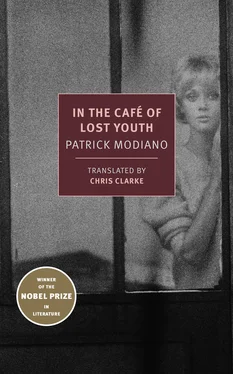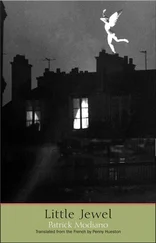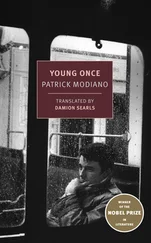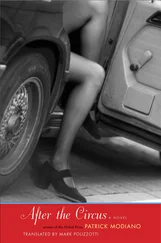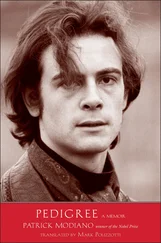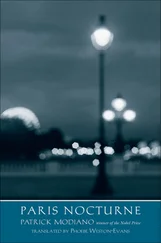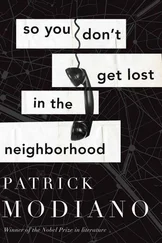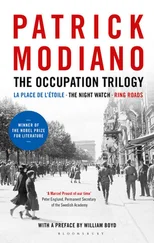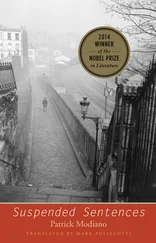Patrick Modiano
In the Café of Lost Youth
PATRICK MODIANO was born in the Boulogne-Billancourt suburb of Paris near the end of the Nazi occupation of France. He studied at the Lycée Henri-IV and the Sorbonne. As a teenager he took geometry lessons with the writer Raymond Queneau, who would play a key role in his development. He has written more than thirty works of fiction, including novels, children’s books, and the screenplay for Louis Malle’s film Lacombe, Lucien . In 2014, Modiano won the Nobel Prize in Literature.
CHRIS CLARKE was born and raised in British Columbia, Canada, and lives and works in and around New York City. His published translations include work by Oulipo members Raymond Queneau and Olivier Salon. He currently teaches French and is translating a novel by Pierre Mac Orlan, which will be published in 2016.
IN THE CAFÉ OF LOST YOUTH
At the halfway point of the journey making up real life, we were surrounded by a gloomy melancholy, one expressed by so very many derisive and sorrowful words in the café of the lost youth.
— GUY DEBORD
THERE were two entrances to the café, but she always opted for the narrower one hidden in the shadows. She always chose the same table at the back of the little room. At first she didn’t speak to anyone, then she got to know the regulars of the Condé, most of whom were about our age, I’d say between nineteen and twenty-five years old. She sometimes sat at their tables, but most of the time she was faithful to her spot, way at the back.
She wasn’t regular about her visits. You might find her sitting there very early in the morning. Or sometimes she appeared around midnight and stayed until closing time. Along with Le Bouquet and La Pergola, it was one of the cafés in the neighborhood that closed the latest, and the one with the strangest clientele. I often ask myself, now that time has passed, if it wasn’t her presence alone that gave this place and these people their strangeness, as if she had impregnated them all with her scent.
Suppose that you were blindfolded, led there, and seated at a table, then your blindfold was removed and you were given a few minutes to answer the question: What part of Paris are you in? You only would have had to observe your neighbors and listen to their comments, and you might have been able to guess: Somewhere not far from the Carrefour de l’Odéon, which in my mind I always picture looking dreary in the rain.
One day a photographer had come into the Condé. Nothing about his appearance distinguished him from the customers. The same age, the same sloppy style of dress. He wore a jacket that was too long, cotton pants, and big army-issue shoes. He took a number of photos of the people who frequented the Condé. He became a regular himself and, as far as the others were concerned, it was as if he was taking family photos. Quite some time later, they appeared in a monograph about Paris, with only the customers’ first names or nicknames as captions. And she appears in several of these photographs. She caught the light better than the others, as they say in the film business. Of them all, she’s the one you notice first. At the bottom of the page, in the captions, she’s referred to as “Louki.” “From left to right: Zacharias, Louki, Tarzan, Jean-Michel, Fred, and Ali Cherif.” “Foreground, seated at the bar: Louki. Behind her: Annet, Don Carlos, Mireille, Adamov, and Dr. Vala.” She has good posture, whereas the others slouch; the one named Fred, for example, has fallen asleep with his head against the imitation-leather banquette and hasn’t shaved in several days. Needless to say, the name Louki was given to her once she became a regular at the Condé. I was there one night when she came in towards midnight and only Tarzan, Fred, Zacharias, and Mireille were left, all sitting at the same table. It was Tarzan who shouted, “Look, here comes Louki.” She appeared frightened at first, then she smiled. Zacharias got up and, with a tone of feigned solemnity, proclaimed, “Tonight, I baptize thee. Henceforth, you shall be called Louki.” And as the hours went by and they all referred to her as Louki, I really think she felt relieved to have this new name. Yes, relieved. Actually, the more I think about it, the more I end up with the same impression I had at first: She was taking refuge here, at the Condé, as if she were running from something, trying to escape some danger. This thought came to me upon seeing her alone, all the way at the back where no one would notice her. And even when she mingled with the others, she didn’t draw attention to herself. She remained quiet and reserved, and seemed happy just to listen. I had even thought that she chose the noisy groups, the loudmouths, to feel safer, otherwise she wouldn’t have been likely to spend all her time seated at a table with Zacharias, Jean-Michel, Fred, Tarzan, and La Houpa. With them, she could blend into the background and was no more than an anonymous extra, one of the people referred to in the photo captions as “unidentified person” or, more simply, “X.” Yes, at first, at the Condé, I never saw her have a one-on-one discussion with anyone. What’s more, there was no drawback to one of the loudmouths calling her Louki because it wasn’t really her name.
And yet, if you watched her carefully, you would notice certain details that set her apart from the others. She took a great deal of care with her clothing, which was unusual among the patrons of the Condé. She lit a cigarette one evening as she sat with Tarzan, Ali Cherif, and La Houpa, and I was struck by the slenderness of her hands. And above all, her nails shone. They were painted with a clear varnish. This detail may seem a bit trivial, so let’s stick to what’s important. First of all, some details about the Condé’s regulars are necessary. Well, they were between nineteen and twenty-five years old, with the exception of a few customers such as Babilée, Adamov, and Dr. Vala who were approaching fifty, but no one paid any mind to their ages. Babilée, Adamov, and Dr. Vala still clung to their youthfulness, men we might describe with the melodious and obsolete moniker “bohemians.” When I look up “bohemian” in the dictionary, I find: A person who leads a wandering life, without rules or worries about the next day. Truly a definition well suited to those who frequented the Condé. Some, like Tarzan, Jean-Michel, and Fred, claimed to have had numerous run-ins with the police since their adolescence, and La Houpa had escaped from the Bon Pasteur Correctional Facility at sixteen. But we were on the Rive Gauche and most of them lived in the sheltered world of literature and the arts. I myself was going to school. I didn’t dare tell this to them, and I didn’t often mingle with their group.
I’d really felt that she was different from the others. Where had she come from before we had given her a new name? Often, the regulars of the Condé had books with them that they would set down nonchalantly on the table before them, the covers stained with wine. The Songs of Maldoror. Illuminations. The Mysterious Barricades . But Louki, at least at first, was always empty-handed. Later, she must have wanted to be like the others, and one day at the Condé I came upon her alone, reading. After that, she was never without her book. She kept it out somewhere noticeable on the table whenever she ended up with Adamov and the others, and it was as if this book were her passport or a residence permit that legitimized her presence by their sides. But nobody paid it any mind, not Adamov, not Babilée, not Tarzan, not La Houpa. It was a pocket book with a soiled cover like one you’d buy used along the quay; its title had been printed in large red letters. A French translation of
Читать дальше
